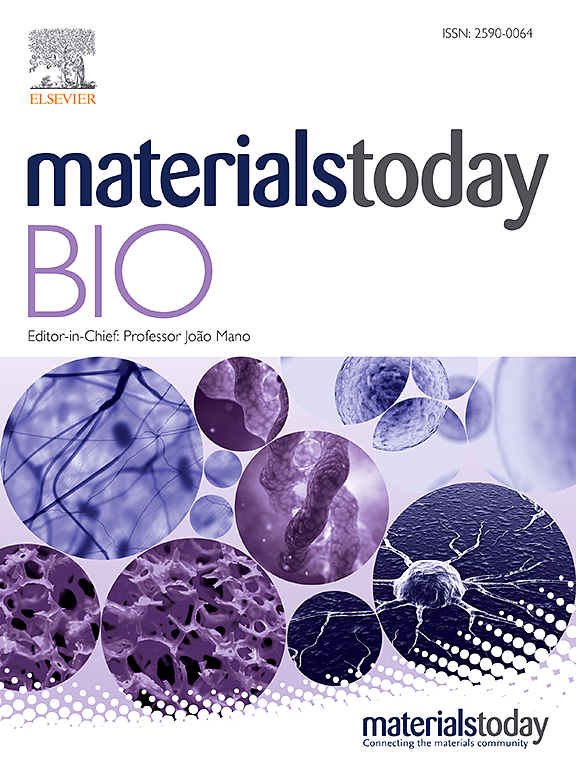通过同时减轻氧化应激和激活自噬,靶向毛囊“种子和土壤”的多功能纳米药物用于雄激素性脱发治疗
IF 10.2
1区 医学
Q1 ENGINEERING, BIOMEDICAL
引用次数: 0
摘要
雄激素性脱发(AGA)是一种普遍的脱发形式,严重影响审美和生活质量。AGA的头发再生需要毛囊从休止期过渡到生长期,同时需要一个类似于种子发芽的健康微环境,在这个微环境中,打破休眠和提供肥沃的土壤是必不可少的。在此背景下,我们提出通过激活毛囊(种子)的自噬和缓解毛囊微环境(土壤)的氧化应激来靶向“种子-土壤”模型可能是AGA治疗的有效策略。通过网络药理学和基于细胞的实验,我们发现姜黄素(Cur)是一种能够激活自噬和减轻氧化应激的潜在药物,这两个过程都是毛囊再生的关键过程。为了促进生物医学应用,我们开发了一种新的纳米颗粒配方,TFC,通过金属配位将Cur和单宁酸与Fe3+自组装。TFC纳米颗粒表现出优异的胶体稳定性,高负载容量(52%)和有效的抗氧化性能。体外研究表明,TFC能有效清除人真皮乳头细胞的活性氧(ROS),激活细胞自噬,对氧化应激具有显著的保护作用。在AGA小鼠模型中,通过微针给药的TFC加速了毛发生长,促进了毛囊增殖,增强了血管生成,与米诺地尔相比,其疗效优于米诺地尔,副作用最小。这项研究表明,通过靶向毛囊细胞的氧化应激和自噬,cu负载TFC代表了一种有希望的AGA治疗新方法。本文章由计算机程序翻译,如有差异,请以英文原文为准。

Multifunctional nanomedicine targeting the 'seed-and-soil' of hair follicles via simultaneous alleviation of oxidative stress and activation of autophagy for androgenetic alopecia therapy
Androgenetic alopecia (AGA) is a prevalent form of hair loss, which significantly affects both aesthetics and quality of life. Hair regeneration in AGA requires the transition of hair follicles from the telogen phase to the anagen phase, alongside a healthy microenvironment, analogous to seed germination, where breaking dormancy and providing fertile soil are essential. In this context, we propose that targeting the "seed-and-soil" model by activating autophagy in hair follicles (seeds) and alleviating oxidative stress in the hair follicle microenvironment (soil) could be an effective strategy for AGA treatment. Through network pharmacology and cell-based experiments, we identified curcumin (Cur) as a potential agent capable of activating autophagy and alleviating oxidative stress—both critical processes for hair follicle regeneration. To facilitate biomedical application, we developed a novel nanoparticle formulation, TFC, achieved by self-assembling Cur and tannic acid with Fe3+ via metal coordination. TFC nanoparticles demonstrated excellent colloidal stability, high Cur loading capacity (52 %), and potent antioxidant properties. In vitro studies showed that TFC effectively scavenged reactive oxygen species (ROS) and activated autophagy in human dermal papilla cells, offering significant protection against oxidative stress. In an AGA mouse model, TFC delivered via microneedles accelerated hair growth, promoted hair follicle proliferation, and enhanced angiogenesis, with superior efficacy compared to minoxidil and minimal side effects. This study suggests that Cur-loaded TFC, by targeting oxidative stress and autophagy in hair follicle cells, represents a promising novel approach for AGA treatment.
求助全文
通过发布文献求助,成功后即可免费获取论文全文。
去求助
来源期刊

Materials Today Bio
Multiple-
CiteScore
8.30
自引率
4.90%
发文量
303
审稿时长
30 days
期刊介绍:
Materials Today Bio is a multidisciplinary journal that specializes in the intersection between biology and materials science, chemistry, physics, engineering, and medicine. It covers various aspects such as the design and assembly of new structures, their interaction with biological systems, functionalization, bioimaging, therapies, and diagnostics in healthcare. The journal aims to showcase the most significant advancements and discoveries in this field. As part of the Materials Today family, Materials Today Bio provides rigorous peer review, quick decision-making, and high visibility for authors. It is indexed in Scopus, PubMed Central, Emerging Sources, Citation Index (ESCI), and Directory of Open Access Journals (DOAJ).
 求助内容:
求助内容: 应助结果提醒方式:
应助结果提醒方式:


